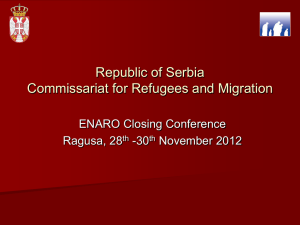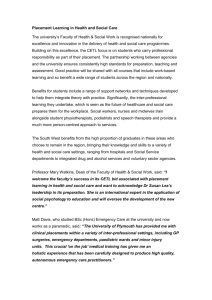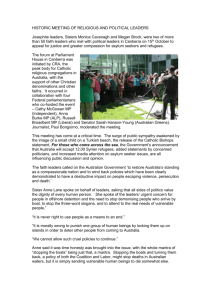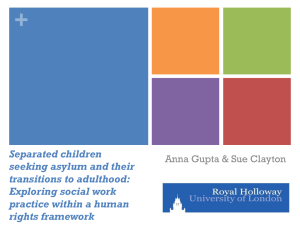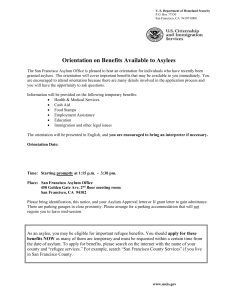Report on SE
advertisement
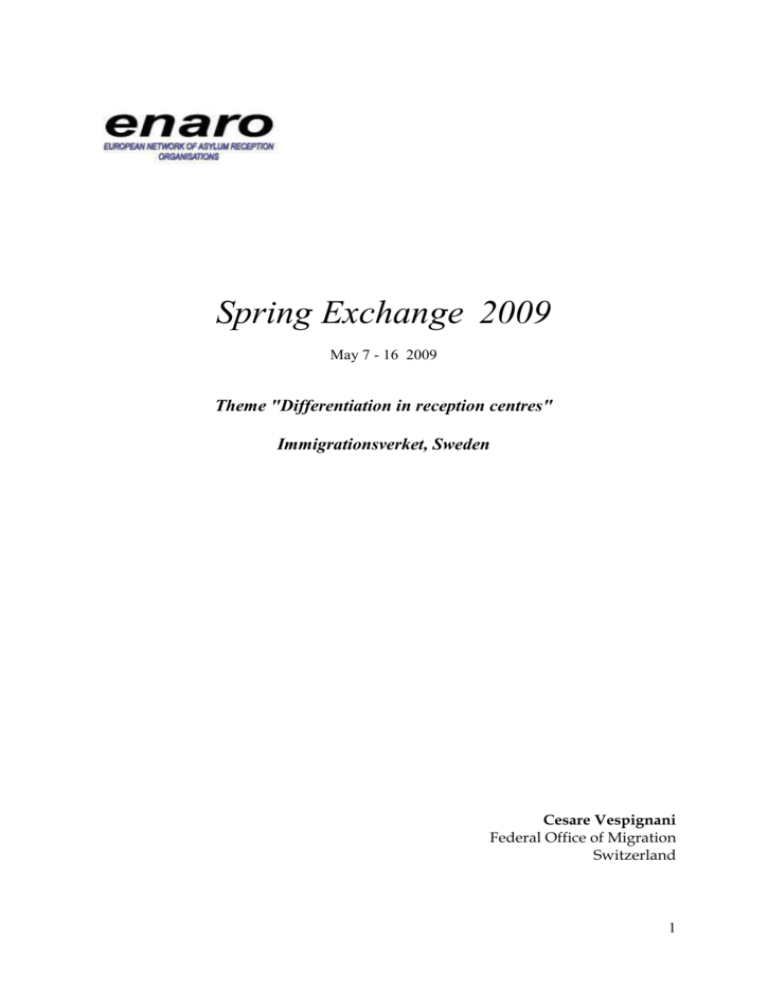
Spring Exchange 2009 May 7 - 16 2009 Theme "Differentiation in reception centres" Immigrationsverket, Sweden Cesare Vespignani Federal Office of Migration Switzerland 1 On differentiation in Reception Centers The Swedish Board of Migration The Swedish Board of Migration maintains several Reception Centers located at different locations in the country. Of these, those at Malmö, Göteborg and Stockholm are the most important ones. Each Center is connected with other 5 or 6 Reception Units distributed in different localities near the Center. While the Centers take care of the initial registration procedures, the verbal examination and the decision of the asylum case, the Units are mainly responsible for the accommodation of the asylum seekers in apartments in small cities and villages in the region. While the asylum investigation is in progress, the Swedish Migration Board offers temporary accommodation. At the time of writing, the Reception Unit of Kristianstad, the Unit I visited during my Exchange Program, located in the southern region of Scania, is responsible of circa 780 asylum seekers accommodated in circa 250 apartments distributed in several communes around Kristianstad. The majority of the apartments belongs to the local municipalities, some, however, are also privately owned and rented to the Migration Unit under a special rental agreement. If the asylum seeker cannot afford to pay the rent, the Board of Migration takes care of it. According to Swedish Migration procedure, asylum seekers are allowed to accommodate themselves with relatives or friends, as long as they leave an address to the Board of Migration. If the asylum seeker is capable and willing to arrange for his or her own accommodation, he or she must, as a rule, meet the cost of the accommodation. Based on a rough estimate, circa 50% of the asylum seekers currently present in Sweden are accommodated among relatives or friends. The reception centers The reception center is the place where the asylum seeking application begins. It is here where the photo and the finger prints are taken, the basic information about the Swedish asylum procedure are handed out, the asylum seeker is registered and the first introductory interview is made. Even after the departure of the asylum seeker to the Reception Unit, the Center continues to be responsible for the application procedure. Even though decision making officers and Dublin procedure officers are also present at the Units, it is mainly at the Centers where the decision regarding an application is taken and where the Dublin procedure is activated and carried out. After having been registered and briefly interviewed, the asylum seekers who are going to be accommodated by the Board of Migration are transferred to a temporary accommodation center located in a converted hotel in the outskirts of Malmö where they remain till the authority finds an apartment to accommodate them. The accommodation center, therefore, is thought to host the asylum seekers only for a few days. The facility is provided with a functioning kitchen with cooking crew, the asylum seekers do not cook and are not required to clean their own rooms since a three-members cleaning crew is available. The facility has no security personnel and is run by a team of two employees. Of particular interest for me was the practice adopted by the Swedish Migration Board to repatriate asylum seekers to Iraq. Currently, in fact, the Swiss Federal Office of Migration only repatriates to the northern section of Iraq, that controlled by the autonomous Kurdish government. The repatriation unit of the 2 Swedish Migration Board, on the contrary, organizes regularly flights to Erbil, Duhok, Bassora and, since October 2008 to Baghdad. The decision making officer I met in Malmö had just returned from a trip to Baghdad with Turkish Airlines (Stockholm-Istanbul-Amman-Baghdad) and considered the journey a complete success (the asylum seeker was a minor affected with polio) praising the authorities in Iraq for their collaboration. Under the Dublin agreement, the unit also organizes repatriation to Greece, including those under category 2 and single women. The Reception Units After having registered the asylum seekers, the case officers of the Reception Center contact those of the Reception Unit to find a suitable accommodation for the asylum seekers. When a suitable apartment is finally found, the asylum seeker travels, generally by train, from the temporary accommodation center to the Reception Center – in Malmö’s case to Kristianstad - where the handling officer responsible for his/her case transports him/her to the assigned accommodation. The Board of Migration tries to place the asylum seekers in an apartment in a normal housing area generally located in the countryside. Single asylum seekers will need to share a room while a family can have its own room but must expect to share an apartment with other people. Although the Migration Board equips the apartment with furniture and the basic necessities required in a household, those asylum seekers who desires a tv or a stereo, must buy it with the money assigned to them by the Migration Board. Moreover, while living in the apartment, the asylum seeker is responsible to look after the apartment, its equipment and surroundings. The handling officers make regular visits to the asylum seekers to inspect the property and to make sure that the technical equipments and installations are functioning properly. The handling officers at the Unit met regularly with the asylum seeker to investigate about the latter’s identity documents, to help him/her to solve daily inconveniences and to answer questions regarding the asylum seeker’s application. The handling officers also functions as a support for the asylum seeker guiding and giving advices to facilitate the asylum seeker’s integration in Swedish society. The Migration Board provides assistance for those asylum seekers deprived of financial means. The daily allowance is 71 SEK for single adults, 61 SEK for adult sharing accommodation, 37 SEK for children up to the age of three, 43 SEK for child aged between 4-10 years old and 50 SEK for children aged between 11-17. The Migration Board estimates that these amounts should be sufficient to pay for food, clothes, shoes, medical and dental care, and other consumables and leisure activities. The daily allowance can be reduced if, for example, the asylum seeker does not cooperate with the authorities or does not come to an appointed investigation meeting. The asylum seeker receives his financial allowance through a Maestro bank card which, being also connected to a supermarket chain, can be used to withdraw money as well as to shop in the supermarket. During the introductory period, the Reception Unit also provides for all asylum seekers – Dublin cases excluded – a free of charge Swedish language instruction. The school I visited in Kristianstad is run by two experienced teachers. Classes are Monday to Friday, from 10 to 12 am, and can last, in theory, till a decision is taken. The Students are divided between those who are able to read and write (alpha) and those who are not; the alpha classes costs the Board 299 SEK per week, 3 the other 231 SEK. In the past, a prolonged absence to school was fined with a reduction of the monthly salary but it was later decided to reverse this decision and to consider the attendance voluntary. The Detention centers The Swedish Migration Board has established several secure centers of accommodation in order to make sure that the asylum seekers remain available for further investigation or for the expulsion procedures. Until 1997, the detention centers were under the responsibility of the police but questions regarding the correctness of mixing criminals and asylum seekers finally led to the take over of the Migration Board. Even after the takeover of the Migration Board, however, the great majority of the inmates are cases belonging to the police. Currently, the Swedish Board of Migration maintains a total of five detention centers for a total of 185 beds. The detention center I visited is located in the village of Örkelljunga. The center, a former youth hostel for boys, was opened in 2004 and houses 20 asylum seekers under the supervision of 24 officers working in team of four. The current facility is considered temporary and the center will move to a new building in 2010 capable of hosting at least 50 inmates. Almost all of the asylum seekers in the center have received a negative decision to their asylum application but have refused to leave voluntarily or are considered by the authority as at risk of disappearing before the expulsion decision can be implemented. According to the Swedish Alien Act, a person could be detained if further investigation is required to fully consider his/her asylum application - in which case the person in question cannot be detained for more than 48 hours – if his or her identity is unclear, if it is likely that the person in question will not be able to remain in Sweden or if a decision has been reached that the person must leave Swedish territory – in which case the person may be detained for up to two months. The average detention period is of 7 days for the cases belonging to the Board of Migration and of 35 days for those belonging to the police. Although the asylum seekers located in the facility can neither go outside nor leave the facility, they are free to move inside the center. Every room houses a maximum of three inmates. There are shared showers and bathrooms, washroom and a kitchen. The food comes from outside twice a day. There is a small gym, two computer rooms with internet connection, a TV room and a table tennis room. The staff of the detention centers does its best to make the sojourn in the center as pleasant as possible for the inmates and encourage them to be as active as possible while in the center and periodically organize activities such as courses of yoga, painting and English language. Every Tuesday the officers met with the asylum seekers for an open discussion about complains and requests. The center has a small internal court where the asylum seekers can breathe fresh air at least one hour every day and provides a special room for religious practices. The center does not maintain a special section for women but they are generally assigned the same rooms – at the time of my visit there were no women in the center and their rooms were occupied by men. Children and their parents can be detained if there is a reason for doing so but neither children nor their parents may be taken into detention if that isolates them from each other. Even though, under exceptional circumstances, an unaccompanied child can be taken into detention, the 4 Migration Board tries to find alternative solution for these cases. At the time of my visit, there were no unaccompanied children present at the center. While detained, the asylum seekers are allowed to receive visits and a special section of the facility is made available for relatives, lawyers and the police. The officers of the Red Cross and of Amnesty International are allowed to visit the entire center. The staff reserves the right to do a body search of the asylum seeker if they suspect that a person is bringing something into the detention center that could harm someone else or disturb the order inside the facility. The officers are not allowed to search a visitor but could search the inmate after the visit. If a particular inmate is considered a threat for his or her own life or for the rest of the inmates, the handling officers can order his or her arrest. Even after this person is taken care of by the police authorities, the handling officers visit him or her at least once a week. Final remarks and conclusion Swedish asylum policy has a long history; Sweden has always been extremely active in giving asylum to individuals and communities under threat. Its neutrality has allowed Sweden to overcome many ideological barriers in order to give protection and asylum to individuals from many different countries. Every country can learn something from the Swedish asylum policy. Particularly interesting, from my point of view, is the difference between Sweden’s und Switzerland’s accommodation policy. The Swedish Migration Board keeps the asylum seekers as briefly as possible in the registration centers and sends them to external accommodations after only a few days from their arrival in Sweden. The Swiss Federal Office of Migration, on the contrary, seeks to keep the asylum seeker in the registration centers as long as a decision regarding his/her application has been taken. It is only when the decision takes more than two months to be taken that the asylum seeker is sent to the assigned Canton. Both procedures offer some positive aspects and some disadvantages. If, for example, the Swiss Registration centers can, at times, be crowded, this system allows the Migration Office to conclude the cases in a relative short time, in many cases in a matter of weeks. By sending the asylum seeker to the countryside, the Swedish Migration Board creates a more relaxed accommodation but, in doing so, it also slows the decision making process down. Furthermore, by being sent to the countryside, the asylum seeker can very easily feel isolated; if he or she can speak neither Swedish nor English, for example, a prolonged sojourn in a small countryside village could be very frustrating, especially if this period is followed not by a positive decision but one of expulsion. To ask the asylum seeker to integrate in Swedish society even when he/she is expected to receive, in the near future, a negative decision can be seen as contradictory and generate confusion and false hopes in the mind of the asylum seeker. Even though the staff of the Swedish Migration Board remains constantly in contact with the asylum seekers to support and help them to solve any inconveniences, the asylum seekers are put in a position in which they have to help themselves: they are provided with money to buy food but it is them who have to go shopping and organize their daily diet, they are given the address of the nearest pharmacy and local clinic but it is them who have to arrange an appointment with 5 the physician, they are given the basic kitchen tools but if they want a TV, they have to buy it with the allowance given to them by the Board. In other words, although the Migration Board provides the basis, the asylum seekers must constantly activate themselves to deal with their daily inconveniences. This system seems very indicate to make the asylum seekers to adapt as soon as possible to Swedish society; it seems to function as a full immersion course in “Swedish way of life”. The classes of Swedish language offered for free by the Migration Board to the asylum seekers from the very beginning of their permanence in Sweden, are a clear example of this policy: to learn the local language is, in fact, one of the most important steps in the integration process. Today’s immigration reality, however, is rapidly changing and a system such as that adopted by Sweden, i.e. a system built to integrate the asylum seekers as rapidly as possible in Swedish society, could not be entirely compatible with the new developments; as a matter of fact, this system could, in some cases, create obstacles and delay the implementation of the new procedures. By assigning precedence and defining responsibilities, for example, the Dublin Treaty is supposed to speed up the asylum procedure for those applicants who have been registered by Eurodac in one of the member countries. To send these applicants to the countryside, however, could complicate and delay the repatriation process, especially if the notification of the expulsion decision does not coincide with the physical expulsion of the asylum seeker. In the same way, to send to school to learn Swedish those applicants whose asylum application would probably be rejected, might involve a waste of energy and resources and generate false hopes. The applicant, in fact, might think that his/her asylum application has been accepted when this is, actually, not the case. Regarding the detention centers, I was surprised to learn that even though the centers are run by the Migration Board, the great majority of the inmates are cases belonging to the police. This situation can create confusion and misunderstandings; the problematic regarding the detention centers is, in my opinion, too delicate to be left in this sort of limbo: the Migration Board should have full authority of all cases under its supervision. At the time of writing, the Swedish Migration Board is already adapting its asylum policy to the new situation; as I write, in fact, the asylum procedure is being shortened and opportunities are being created to direct the asylum seeker toward the internal job market. In the near future, for example, the language course in Swedish will be modified ad personam to respond to those asylum seekers who have a specific professional background. To be ready to reconsider one’s own asylum procedure is, in itself, a demonstration of mental flexibility and human sensibility. To modify an asylum procedure is a process that involves not only the sphere of the Migration Board but also the social and the political ones. It is, indeed, a reconsideration of the way in which a society looks at itself. Without abandoning its traditional approach to the subject, the Swedish Migration Board is already projecting itself in the future and is actively involved in trying to respond effectively to the constantly evolving reality of the asylum issue. 6 NAME ORGANISATION COUNTRY HOST COUNTRY CONTACTPERSON HOST COUNTRY & E-MAIL Cesare Vespignani Federal Office of Migration Switzerland Sweden Gunnel Segerfeldt, Sweden; gunnel.segerfeldt@migrationsverket.se 7

